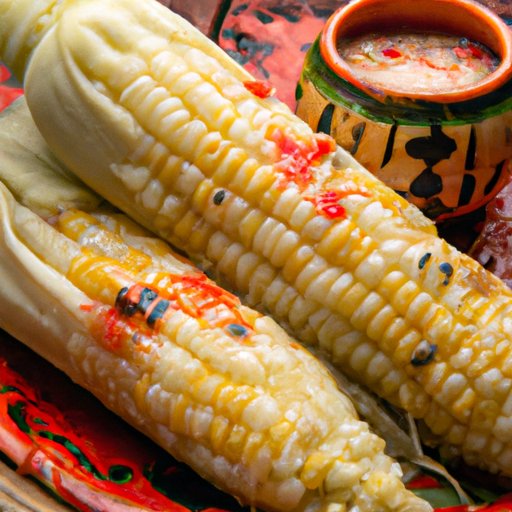Introduction
Elote is a beloved Mexican street food that has become increasingly popular worldwide. This delicious and easy-to-make dish is perfect for outdoor gatherings and barbecues and is guaranteed to impress your guests. In this article, we’ll provide a step-by-step guide to making elote, explore its cultural significance and historical context, offer alternative recipes and seasonal variations, and even provide an advanced guide for experienced chefs. So let’s get started!
Step-by-Step Guide to Making Elote
To make elote, you’ll need the following ingredients:
- Corn on the cob
- Butter
- Salt
- Cotija cheese
- Chili powder
- Lime
- Mayonnaise (optional)
Here’s a step-by-step guide to preparing and cooking elote:
- Husk the corn but keep the stem attached.
- Boil the corn for 5-10 minutes or until it’s tender. Drain the corn and let it cool for a few minutes.
- Preheat your grill or grill pan to high heat.
- Melt the butter in a small saucepan over low heat. Add a pinch of salt and stir.
- Brush the corn with the melted butter and place it on the grill. Grill the corn for 3-5 minutes on each side, or until it’s slightly charred.
- Remove the corn from the grill and let it cool for a few minutes.
- Spread the mayonnaise (if using) on the corn, and crumble cotija cheese over the top.
- Sprinkle chili powder over the cheese and squeeze lime over the top. Serve immediately.
Here are some tips and suggestions for beginners:
- Be sure to brush the corn with butter before grilling to prevent it from drying out.
- If you don’t have a grill or grill pan, you can also broil the corn in your oven on high for 3-5 minutes on each side.
- Experiment with different toppings such as chopped cilantro, hot sauce, or diced tomatoes.
Historical Context and Cultural Significance
Elote has a long history in Mexican cuisine and is considered a staple street food. Traditionally served on a stick, elote is enjoyed all year round but is most popular during the summer months. The dish has also spread globally and is now enjoyed in other parts of the world, especially in the United States.
Elote’s cultural significance lies in its ability to bring people together and is a symbol of Mexican culture. For many, it represents a sense of community and is a way to connect with traditions and heritage.
While the exact origins of elote are unclear, it’s believed to have originated in central Mexico. Over time, the dish has been adapted to include different toppings and flavorings based on regional availability and preferences.
Seasonal Spin
While classic elote is perfect for summer barbecues, you can also adapt the dish to the winter months by swapping the grilling for roasting. Instead of grilling the corn, you can wrap it in foil and roast it in the oven at 400°F for 20-30 minutes. Serve with melted butter, cotija cheese, and your favorite winter spices like cinnamon or nutmeg.
You can also experiment with seasonal toppings such as roasted butternut squash, pomegranate seeds, or roasted red pepper. These toppings will add a burst of flavor and color to your dish.
Advanced Techniques
If you’re an experienced chef and want to take your elote game to the next level, try smoking or curing your corn on the cob before grilling. Smoking the corn will add a smoky flavor to your dish, while curing it will give it a more complex flavor profile. Here’s how you can do it:
- For smoking: Soak the corn in water for 30 minutes. Prepare your smoker according to the manufacturer’s instructions. Place the corn on the smoker, and smoke for 1-2 hours until the corn is cooked through. Follow the instructions for grilling as outlined above.
- For curing: Mix equal parts salt and sugar in a bowl. Coat the corn with the mixture and let it sit for 24 hours. Rinse the corn and grill as outlined above.
Health Benefits and Variations
Elote is a relatively healthy dish. A medium-sized ear of corn contains approximately 77 calories, and it’s also a good source of fiber, vitamins, and minerals.
If you’re a vegetarian or vegan, you can still enjoy elote by omitting the cheese and mayonnaise. You can also experiment with different plant-based toppings such as vegan parmesan cheese, cashew cream, or nutritional yeast.
If you’re looking to make adjustments to the recipe to cater to different diets or nutrition goals, you can try reducing the amount of salt or butter used or substituting them with healthier alternatives such as olive oil or coconut oil.
Conclusion
Elote is a delicious, easy-to-make dish that is perfect for any occasion. With our step-by-step guide, you can now make your own authentic elote in the comfort of your own home. Remember to experiment with different toppings and flavorings to make the dish your own. We hope you enjoyed this article and encourage you to try making elote for yourself.
